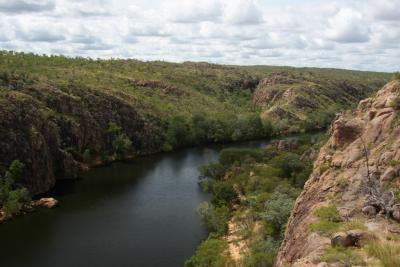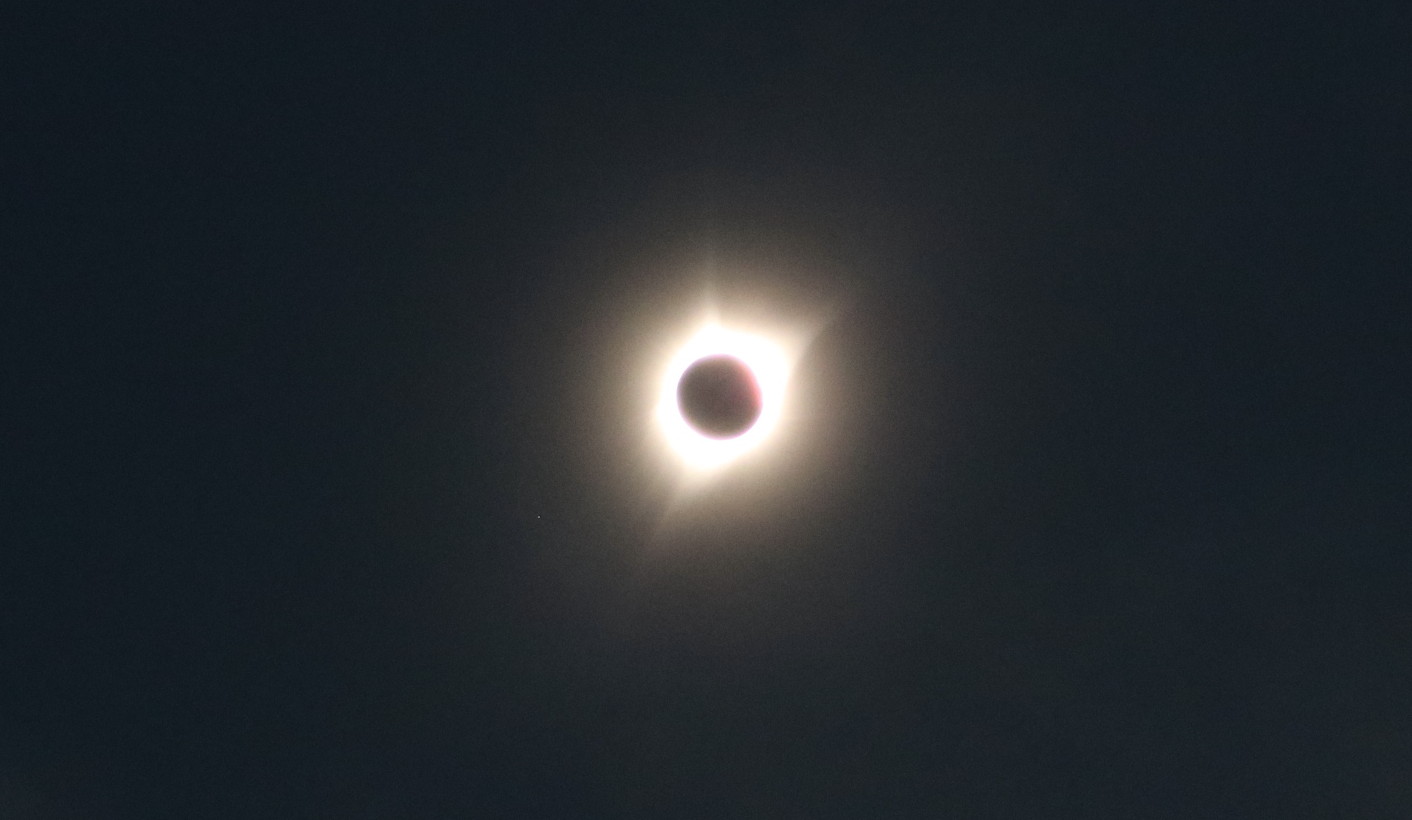Nitmiluk National Park
 Nitmiluk National Park is a small park just a few kilometers east of Katherine in the Northern Territories. The primary feature of Nitmiluk is the Katherine River which has cut a gorge into the rocks. The gorge is rather unique in that it developed as the rocks were lifted. With its path established prior to the rocks being lifted, it encountered resistant rocks and created a new path along the stress cracks in the rising rocks. These stress cracks are in a pattern with near 90 degrees angles between two systems of cracks. The result is a gorge which is a series of stair-step zigs and zags. In the case of the Colorado River, the meandering pattern of the river set the course for the Grand Canyon as the Colorado simply continued on its established course cutting deeper and deeper into soft rocks. In the case of Nitmiluk and the Katherine River, the rocks were very hard and thus played a role in establishing the pattern.
Nitmiluk National Park is a small park just a few kilometers east of Katherine in the Northern Territories. The primary feature of Nitmiluk is the Katherine River which has cut a gorge into the rocks. The gorge is rather unique in that it developed as the rocks were lifted. With its path established prior to the rocks being lifted, it encountered resistant rocks and created a new path along the stress cracks in the rising rocks. These stress cracks are in a pattern with near 90 degrees angles between two systems of cracks. The result is a gorge which is a series of stair-step zigs and zags. In the case of the Colorado River, the meandering pattern of the river set the course for the Grand Canyon as the Colorado simply continued on its established course cutting deeper and deeper into soft rocks. In the case of Nitmiluk and the Katherine River, the rocks were very hard and thus played a role in establishing the pattern.
Trails within the park provide access to viewpoints overlooking the gorge and the Katherine River. The river itself is navigable for short distances between falls and rapids so they have boat tours and canoe rental. There is no swimming in the river because of the crocodiles. That’s a good enough reason for me! We never saw a crocodile but I’m not going to put my toe in the water to test that observation.
We spent some time in the visitors center. They had an excellent interpretative exhibit which explained a number of things we have noticed and/or wondered about. One of the most interesting was the information about termites and their role in the ecology of the tropical rain forest. Termites it turns out will eat the heartwood out of trees. The heartwood is the wood in the center which is no longer transporting nutrients and water to the leaves. In its place, the termites store organic matter which is another food source for them. This organic matter decays and fertilizes the tree. So as they attack the tree they are also beneficial to the tree. In addition, their hollowing of the interior trunk and branches of the trees results in hollow places in trees in which animals live. The exhibit stated that an amazing half of all mammals here in the rainforest live in cavities produced by the termites. But that wasn’t all, one fourth of all reptiles (think lizards) live in these cavities and one fifth of all birds in the tropics live in these cavities as well. The Aborigine used the hollow branches of trees to make one of their musical instruments, the didgeridoo. So, it turns out that termites aren’t all bad. At least when they are not attacking your house! As an aside, the utility poles in this part of the country are all metal poles, there are no creosote soaked poles here. My guess is that a wooden pole wouldn’t last long with the abundance of termites that exist here.
Other exhibits showed the scientific explanation of the formation of the gorge as well as the Aborigine legends about the formation of the gorge. This was particularly well done with an exhibit that displayed both sets of information on a ribbon with one side being the science and the other being the legend. The entire exhibit area was one of the best and most informative that I have seen anywhere and I told a staff member just that.
After exploring the exhibits we hiked to the viewpoint closest to the visitors center. Starting the hike we were greeted by a huge flock of fruit bats hanging in the trees along the river. These were the same kind of bats we had seen a month before near the visitors center in Boonah as we wound up our trip on the New England Highway. Here they were in their native habitat in the northern rainforest. Just as before they were flapping trying to keep cool on a bright sunny day. We noticed that they stopped their flapping and their noise stopped as soon as a cloud blocked the sun. It was an amazing change in behavior with just a little cloud.
Continuing the hike, we climbed up the cliff face on a series of metal stairs followed by more stairs cut into the rocks. The rocks were fascinating with alternating layers of sandstone and conglomerate. Some of the sandstone looked like the sandstone at Uluru while the conglomerate reminded us of the Kata Tjuta.
Eventually we reached a platform built out on the edge of the cliff overlooking the gorge and river. From there you could see both upriver and downriver along a good stretch of the gorge as well as looking out over the landscape in the area around the river. This was the lower end of the gorge so looking downriver there was quite an expanse of land visible.
Just uphill from the viewing platform was a canvas shade with a bench. We made that our picnic area, breaking out a simple lunch, we had a great view, shade from the sun and a nice breeze on top of the hill. The trail continued on past the water treatment plant and water storage tanks for the drinking water at the park offices and campground. From that location we were overlooking the entire developed complex of the park.
The trail followed the access road for the water treatment system back to the main park road and the visitors center. Hiking along the road we enjoyed flowers, rocks and birds. All these were new and different from what we see in the US as well as what we have seen here in Australia. The heat of the day began to affect Louise so we had to slow our progress and take advantage of the available shade. We had plenty of water with us so there was no emergency but we have a new rule now, no hiking if we aren’t on the trail by 10:00 a.m. The mid-day heat gets to be oppressive. Perhaps this will abate, this is fall in the southern hemisphere but in the tropics there are really no seasons like we are used to at the mid-latitudes. April is the beginning of the dry season here, referred to only as the Dry. That will last until August when the storms from the Pacific and Indian Oceans begin to bring rains to the area. That is known as the Wet.
Our hike concluded at the visitors center where we found ice cream and cold drinks and air conditioning to drain away some of the heat of the hike. Returning to the campervan we changed into cooler and dry clothes and then returned to camp for a good shower.



0 Comments
Recommended Comments
There are no comments to display.
Please sign in to comment
You will be able to leave a comment after signing in
Sign In Now